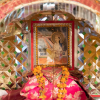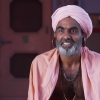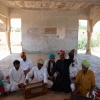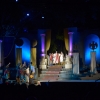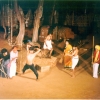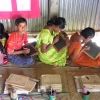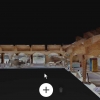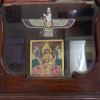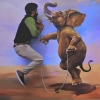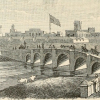My name is Naranbhai Ukedbhai Rathva. I am from here, Tejgadh. I have an MA in Sociology. I completed a two-year post graduate Tribal Diploma at the Adivasi Academy in 1998. Initially, when Dr. Devy first met us, he spoke a lot about future of Adivasis. We discussed that here; in this place there would be something like an Adivasi house, Adivasi village. We did not imagine that it would just like an Adivasi village, houses like traditional Adivasi houses, houses like old times. When the construction was completed, it seemed like our ancestors have built these houses. Similarly, everything to be created here should be on similar lines. Suppose we build a museum then Adivasis of entire country should be represented. Based on this objective the museum was built. The library was also established keeping the same thing in mind. Different types of projects based on the problems of the Adivasis... And on similar terms a diploma was also started. He had a vision, that this place is close to Madhya Pradesh which is 40 km, Maharashtra is 80 km and Rajasthan is about 100 km. This location is such that the entire eastern belt, the entire Adivasi belt of four states meets at this place, at the Adivasi Academy, at its location. Another reason to select this place was because of the 1000-year-old rock paintings. These rock paintings are proof that the Adivasis resided in this place. Rivers are also a reason to build the Academy here. Narmada is near, so is Tapi, and also Mahisagar river. All these big rivers flow through the habitations of the Adivasis. All this was in the study of Dr Devy and in this way this area was selected, here in Tejgadh. This is the little history that I know.
When Dr Devy talked to us on the subject of Adivasis in his lectures in the beginning, it was then I realized more about Adivasis. I myself am an Adivasi, but I did not know what being an Adivasi meant. At that time, the Tribal Diploma was also started. And through this diploma I got to know all about Adivasis, like how many different types of Adivasis are there in the country, their lifestyles, their cultures and other things were there in the study. In the beginning I was one of the first students from the batch of 15. Amongst various topics one special subject was art. I was very interested in the subject of art. Dr Devy asked me to focus on art, on the museum. I was assigned the museum. He told me, 'It is you who has to make the museum ready.' Actually I am not a museologist. Nor am I that educated. But I was asked to do fieldwork in several museums of the country. To understand why a museum is built, what is there in a museum? I went to each and every museum with these questions, and observed them first-hand, to really understand what is there.
Mostly I got to see about kings and kingdoms. And from those museums, I realized that everyday artifacts like these (what we have in Vaacha) should be kept and people will come to see them. That is what it was. The museum of Tejgadh is named Vaacha, it is an entirely open space. I used to wonder, where would I keep all the artifacts I collected? Devy Sir had a different vision about it, he said, we will create such a museum which will showcase the Adivasis and national and international institutions can recognize and study the culture of Adivasis. Back then I thought, The artifacts that I collect, I will keep them in such a way that people know there is a museum here. Based on this thought, we collected a lot of photographs and artifacts, which would help people who visit for research, study, to undertake their study systematically here first, and then they can visit the villages from where they can collect further information. This is how I thought the museum should be developed. In Vaacha, works of approximately 64 communities of the country have been collected. I have been writing about these works for the past 15-20 years, some are documented in audio-video format. This way I have created the museum. I get a lot response about the museum. The students of schools, colleges and universities receive guidance from this museum and they find it very useful.
The name of the museum is Vaacha. Vaacha means ‘voice’. Sir’s thought was that this voice, the Adivasi voice does not reach to people. So the ‘Voice of Adivasi’ will reach through this museum and people will listen to this voice in some form or the other. For this reason, the museum was named Vaacha. Especially I have here collected musical instruments from different communities of the country. I have collected 160 musical instruments. Similarly, there are religious rituals of the Adivasis, where people create special paintings, I have collected several paintings from various communities of the country. Articles of kitchen and cooking, clothing and textiles, some make art from wood, some make necklaces from beads, and some especially work in embroidery, some work in clay, some work in bamboo. So communities were involved with the formation of museum as well. Besides this, their knowledge and science, for example their apparatus for grinding grains was collected, apparatus for making alcohol along with its technique, storage containers for rice, and similar artifacts have also been collected by me from the various communities of the country.
For last 20 years, I have collected approximately around 50,000 photographs of Adivasis in various forms. When we sat down to see the collection, we decided that instead of just keeping these photographs in the museum, we should create an archive. We decided to create Bhasha Archive. We created a website, so that it becomes the sole resource for the photos. From 50,000 we were able to upload around 5,000 photographs. Even now, slowly and steadily, little by little every year photographs are being uploaded to the website. Through this website and photographs, people will get a lot of help in their research. A lot of people have seen it and responded well. Similarly, we have documented over 1,000 hours of audio-visual data. We have also begun to upload these documents on the website. Last year, we uploaded approximately 20 videos and 100 or so audios have been uploaded. In this way, slowly we will host all of our documentation online. Simultaneously, a lot of writing takes place, which is being kept in an eBook format. Last year, we uploaded around 40 versions of eBooks. We also organize several small exhibitions. For example, we organized a big exhibition titled ‘Purvajon ni Ankh’ (Through the Eyes of our Ancestors) only in Adivasi villages or locations of ancestral importance. Dr Devy saw many photographs of India in the archive of Limerick University of Ireland, he spoke with them and asked them to share these photographs. This way, Dr. Devy brought back with him around 160 photographs which were almost 80 years old from Limerick University for the museum. From this we organized a big exhibition titled ‘Purvajon ni Ankh’ (Through the Eyes of our Ancestors). In this exhibition, people from 40 countries took part. The local people also participated in it like a festival and came with dhol and nagara. They transformed the exhibition into a festival.
In January-February, especially in February on Mahashivratri, when the Kaleshwari Mela (Fair) takes place, artists from De-Notified Tribes (DNTs) and Adivasis, musicians, dancers, singers and similar artists come. Similar activities take place when I organize the Tur Mela in Tejgadh. Tur is a musical instrument from South Gujarat played especially on sad occasions. This musical instrument can be played in 53 different voices. So an instrument with such varied scope is now being neglected. Dr Devy thought that we should start a mela around this instrument and make an audio CD. The artists who perform in this mela are well documented. At the end, we ask all the artists to play together. This mela is a symbol of Unity. The reason for this documentation is to preserve Adivasi music in villages where Hindi or Gujarati film songs are heard more by people, especially on bus depots, in shops. After the documentation is done this is given back to villages so that Adivasi songs can be heard and played. We have received great response for this. We made an audio CD named Timli; I distributed around 1000 copies of it in my own locality.
To develop the museum, we have been taking new research. In the beginning, when meetings about languages took place, it was decided to create a Bhasha Van (Forest of Languages) in this campus. It was decided that this Van should constitute, the scheduled and non-scheduled languages, language families of our country. For this, several trees have been given code numbers. When visitors come, we give them audio guides and headphones. Visitors go up to the trees, press the numbers, so they get history, some old song, some old story of a particular community. This is the structure of this Bhasha Van. The thought was preservation of environment through the work of Bhasha Van. The idea is, when trees get motivation they grow: in a similar manner language also grows and spreads. We have documentation of about 70 languages on various trees with numbers along with posters. The end of it would be completion with 780 languages in Bhasha Van.
We have created an online resource called National Consortium of Tribal Arts. In this online resource, we proposed to the Central Government that out of eighteen Tribal Research Centers of our country, documentation of fourteen Tribal Research Centers come together in one place through Central Government. We proposed four major points, one that a big book of National Consortium should come out, secondly a state level catalogue, third a website and fourth a virtual museum should be made. The virtual museum is such that it can be viewed via a touchscreen in every TRI (Tribal Research Institute), and through the help of a projector it can be broadcasted for visitors. In this way, we brought together collections of 14 Tribal Research Centers in one place. Along with this we put forth the thought of Gujarat nu Aadim Sangit (Adivasi Music of Gujarat. For this we ourselves documented about 70 communities of Gujarat.
We have started a Lakhara Studio. In our Adivasi world the painter is called Lakhara. We have built the structure, and have painted 8-10 forms of paintings which have been done by our local people. Our thought behind this is to preserve the Adivasi paintings. In future, we have decided to create a DNT (De-Notified Tribal) Museum. The work is on, collection of artifacts, its documentation has begun. Next to it will be ‘Bij’ which will showcase our focus on music. In this way, the campus of our Adivasi Academy is being filled and voices of Adivasi should be heard in the entire country from this academy.
In the beginning, when I joined Adivasi Academy and Bhasha Research and Publication Center, Dhol magazine’s publication had just begun. I used to write on a Rathvi Dhol, for that magazine. In ‘Dhol’, I had started writing some stories and songs of Adivasis also. Similarly, we started ‘Bol’, a weekly magazine for small children. I wrote for small children, on musical instruments, on medicines, on art. Baba Pithora is celebrated on a large scale in Rathva society, it is a religious pilgrimage. It is worshipped in every home. I felt that this Baba Pithora painting is one of the oldest religious rituals of the Adivasis and no one has written anything about it yet. The literature of it is very vast. One can make a Ramayana and Mahabharata; it has that amount of associated literature. So I felt I will do research on it and I researched on it and in some months the book will be out. It is 400 pages of research work compiled and written in this book. Another publication of mine is Rathva Samajna Lagna Gito (Marriage Songs of Rathva Community), almost 500-550 songs are sung by women and sisters for one wedding. I felt that they all will be extinct. So I collected and documented the 550 songs and created a book and an audio CD. Similarly, in this area there are historic cave paintings, which are almost 1000-year-old painted by Adivasis. I have found almost fourteen such paintings in this area. I have researched and published a book it as well. I have also guided several researchers and Ph.D. scholars who come here. Right now I writing something or the other, so that I can also come out in the form of a Lakhara.



